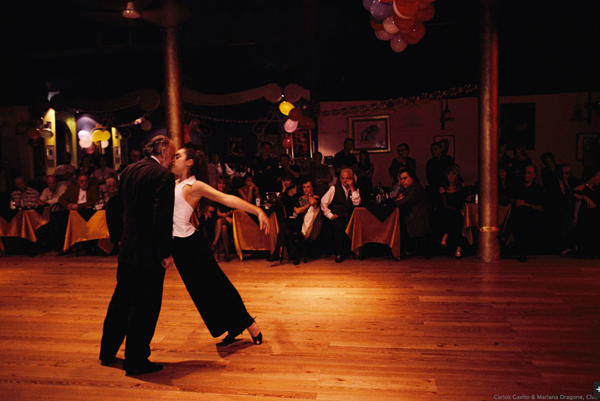Photographs and text by Pablo Corral Vega
Life is not life without poetry. I?m talking about the license we give the world to touch us, change us, wound us, carry us away, lift us up, drag us down, save us, expose us, wrap us in warmth, strip us naked.
Uno, Enrique Santos Disc?polo?s beloved tango, says, ?Filled with hope, we seek the path our dreams have promised our desires. . . The struggle is hard, and it is long, but struggle anyway, and bleed for the faith that drives you on. Through the thorns we crawl, and in our thirst to give our love, we suffer and destroy until at last we see that we?ve no heart anymore ? the price of a punishment we undergo, a kiss we never receive, a love that left us low. . . ?
When we live with poetry, we risk our heart, our feelings, our peace. We risk our mind, our skin, our bones.
The tango is the music of immigrants ? Italians, Spaniards, Germans ? who came to the area of the R?o de la Plata in the late nineteenth century. They had left everything behind ? it?s only natural that the tango is filled with nostalgia. But it?s not an unredeemed nostalgia; quite the contrary. It?s a nostalgia that is transfigured by an embrace, that finds harbor in the dialog of bodies. The music and lyrics of the tango are pure nostalgia, but the dance itself is all sensuality, presence, exchange. Redemption.
Nostalgia and sensuality need one another and nourish one another. It?s a virtuous circle: to overcome nostalgia one must declare the triumph of the senses, assert the concrete importance of the here and now. And afterward, the senses ? when one is fully alive ?become the source of nostalgia.
When I went to Buenos Aires for the first time, the tango shows seemed so false to me, the sensuality so exaggerated, the gestures so lacking all poetry that I thought the tango was dead. About that experience I wrote this:
?It?s raining, and it?s been raining since the moment I arrived. Abandonment is made of rain, of unceasing processions of rain, of unexpected seasons of rain, of narrow slits of sun through the rain. Abandonment is made of sad love affairs, of love affairs marked by silence, of love affairs that try to stay afloat despite all the rain. No, it?s not that all love affairs are sad, or that rain shapes our destiny. No, I?m not talking about that. I?m talking about the fact that this long, profound abandonment is made of other, smaller abandonments, of words never spoken, of gestures of tenderness that were never born, of impossible embraces.?
Driven by the rain, nostalgia penetrated my bones. And then the tango took me by storm, so to speak ? another sort of storm. I met Tito, a street poet, a vendor of wine and shoes, a loco who danced tango every night of his life. With him, I wandered through the Buenos Aires night. I discovered that the tango is alive in hidden, private places that the tourist never sees. It?s a world with its own laws. In the milongas ? the places where people go to dance ? the pimps and housewives, the lovers and the grandparents still together after all these years, the marginal males and the gay divorcees, the powerful and the nobodies, the young and those who can?t bear to grow old are all still to be found. All in the same place, playing their juxtaposed roles, actors in a delicious comedy that?s reinvented every night. They all laugh and pretend they aren?t dying. But when they step onto the dance floor, they do so with devotion, in silence, as though in that embrace their entire destiny were on the line.
Fernando Gavito, a friend of my friend Tito?s, was one of those devotees. Considered the greatest tango dancer in Buenos Aires, when he stepped onto the dance floor everyone that looked at him held their breath. His slow, deliberate movements challenged the law of gravity; they defied every notion of balance that one had ever entertained. I remember one night at the Club Gricel, shortly before his death. Mariana, his dancing partner, leaned against him, held up by nothing more than Gavito?s forehead and the tips of her own toes. It was an act of absolute surrender. The slightest error would have brought them both tumbling to the floor. That photograph has become, for me, the absolute definition of eros: I surrender to you with absolute certainty; you are my balance.
The most revealing definition of tango comes from the old men of the night: tango is embrace. More than music, more than the poetry of the old-time language of lunfardo, more than the constant flirting and the overwhelming presence of the senses, it is the embrace that expresses our humanity ? more than any other thing we do. When we embrace one another we rescue one another from abandonment, we identify ourselves as members of our species. An embrace is a powerful, alchemical tool: it turns sadness into sweet. We are the species that embraces, that takes in, that touches, that swathes, that protects. The tango turns an embrace into human poetry.
